East Asian hip-and-gable roof
The East Asian hip-and-gable roof (Xiēshān (歇山) in Chinese, Irimoya (入母屋) in Japanese, Paljakjibung (팔작지붕) in Korean) consists of a hip roof that slopes down on all four sides and integrates a gable on two opposing sides.[1][2] It is usually constructed with two large sloping roof sections in the front and back respectively, while each of the two sides is usually constructed with a smaller roof section.[3]
The style is thought to be Chinese in origin, and has spread across much of Asia. The original style and similar styles are found in the traditional architectures of India, Japan, Korea, Vietnam, Mongolia, Tibet, Nepal, Sri Lanka and Kalmykia. It also influenced the style of the bahay na bato of the Philippines.
Etymology
It is known as xiēshān (歇山) in Chinese,[4][5] irimoya (入母屋) in Japanese,[2] and paljakjibung (팔작지붕; 八作--) in Korean.[6]
Irimoya in Japan
Irimoya arrived from China to Japan in the 6th century.[2] The style was originally used in the main and lecture halls of a Buddhist temple compound. It started to be used for the honden at shrines later, during the Japanese Middle Ages.[7] Its gable is usually right above the moya, or core, while the hip covers the hisashi, a veranda-like aisle surrounding the core on one or more sides.[2]
It is still in wide use in Buddhist temples and Shinto shrines in Japan, and also in palaces, castles, and folk dwellings. In the last case, it is often called moya-zukuri (母屋造).[2]
Kandyan roof of Sri Lanka
In Sri Lanka, a style known as the Kandyan roof bears many similarities to the original East Asian hip-and-gable roof. The Kandyan roof is primarily used for religious, and historically, royal buildings. Its roots however lie in the traditions of the "Sri Lankan village".[8][9]
Gallery
 File:Longxing_Temple_2.jpgThe Longxing Temple—built in 1052, located at present-day Zhengding, Hebei Province, China—has a hip-and-gable with double eaves.[5]
File:Longxing_Temple_2.jpgThe Longxing Temple—built in 1052, located at present-day Zhengding, Hebei Province, China—has a hip-and-gable with double eaves.[5]
.jpg) File:National_Concert_Hall_(Taiwan).jpgNational Concert Hall in Taipei
File:National_Concert_Hall_(Taiwan).jpgNational Concert Hall in Taipei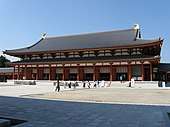 File:Yakushiji_daikodo.jpgYakushi-ji's (Dai)kō-dō
File:Yakushiji_daikodo.jpgYakushi-ji's (Dai)kō-dō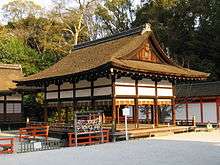 File:Kamomioya-jinja_hashidono.jpgA hip-and-gable roof at Shimogamo Shrine
File:Kamomioya-jinja_hashidono.jpgA hip-and-gable roof at Shimogamo Shrine File:Shikoroyane.svgA shikoro-yane
File:Shikoroyane.svgA shikoro-yane File:Shitennoji_main_gate.jpgShitennō-ji main gate and its shikoro-yane
File:Shitennoji_main_gate.jpgShitennō-ji main gate and its shikoro-yane- File:Tamamushi_Shrine.JPGThe Tamamushi Shrine has a shikoro-yane
 File:Sri_Lanka_-_029_-_Kandy_Temple_of_the_Tooth.jpgThe Kandyan roof style of the Temple of the Tooth in Kandy, Sri Lanka
File:Sri_Lanka_-_029_-_Kandy_Temple_of_the_Tooth.jpgThe Kandyan roof style of the Temple of the Tooth in Kandy, Sri Lanka- File:Great_Drigung_Kagyud_Lotus_Stupa.JPGThe Great Drigung Kagyud Lotus Stupa in Lumbini, Nepal
 File:Mahamevnawa_Buddhist_Monastery_Polgahawela.jpgThe Mahamevnawa Buddhist Monastery in Polgahawela, Sri Lanka
File:Mahamevnawa_Buddhist_Monastery_Polgahawela.jpgThe Mahamevnawa Buddhist Monastery in Polgahawela, Sri Lanka
 File:Bahay_Na_Bato_Cebu.jpgA Bahay na bato in Cebu, Philippines
File:Bahay_Na_Bato_Cebu.jpgA Bahay na bato in Cebu, Philippines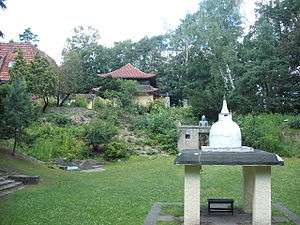 File:PaulDahlkeHaus.jpgDas Buddhistische Haus in Berlin
File:PaulDahlkeHaus.jpgDas Buddhistische Haus in Berlin
 File:Iringol_Kavu_Temple_Perumbavur_Kerala_India_DSC_5418.jpgIringol Kavu Temple, Kerala, India
File:Iringol_Kavu_Temple_Perumbavur_Kerala_India_DSC_5418.jpgIringol Kavu Temple, Kerala, India File:Mannar_Thrikkuratti_Mahadev_Temple,_Mannar,_Kerala.jpgMannar Thrikkuratti Mahadeva Temple, Kerala, India
File:Mannar_Thrikkuratti_Mahadev_Temple,_Mannar,_Kerala.jpgMannar Thrikkuratti Mahadeva Temple, Kerala, India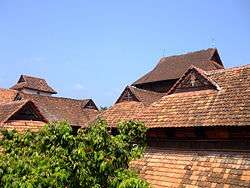 File:Padmanabhapuram_Palace,_roof_works.jpgPadmanabhapuram Palace, Kerala, India
File:Padmanabhapuram_Palace,_roof_works.jpgPadmanabhapuram Palace, Kerala, India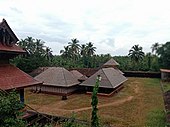 File:Sree_Madiyan_koolom_Temple_kasaragod_kerala.jpgSree Madiyan Koolom Kshethrapalaka Temple, Kerala, India
File:Sree_Madiyan_koolom_Temple_kasaragod_kerala.jpgSree Madiyan Koolom Kshethrapalaka Temple, Kerala, India
See also
- Gablet roof
References
- Guo, Qinghua (2010). The mingqi pottery buildings of Han Dynasty China, 206 BC-AD 220 : architectural representations and represented architecture. Brighton: Sussex Academic Press. p. 138. ISBN 9781845193218.
- "Irimoya-zukuri". JAANUS: Japanese Architecture and Art Net Users System. Retrieved 2009-05-31.
- Deqi, Shan. Chinese vernacular dwellings. Cambridge: Cambridge University Press. pp. 11–12. ISBN 9780521186674.
- Chen, Congzhou; Pan, Hongxuan; Lu, Bingjie (2008). Chinese houses : a pictorial tour of China's traditional dwellings. Pleasantville: Reader's Digest Association. p. 331. ISBN 9781606520017.
- Chung, Anita (2004). Drawing boundaries : architectural images in Qing China. Honolulu: Univ. of Hawai'i Press. pp. 23–24. ISBN 9780824826635.
- "Naver Dictionary". Retrieved 2013-03-10.
- Iwanami Nihonshi Jiten (岩波日本史辞典), CD-ROM Version. Iwanami Shoten, 1999-2001.
- Architecture and Identity, pg 491
- Senarat Paranavitana Commemoration Volume
.svg.png)
